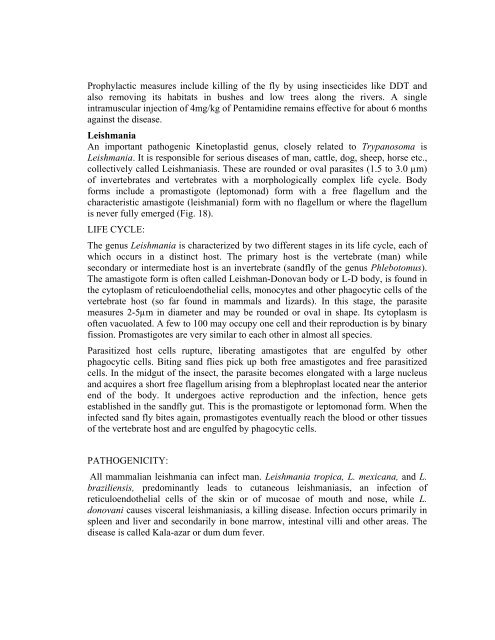ANIMAL DIVERSITY – I (NON-CHORDATES)
ANIMAL DIVERSITY – I (NON-CHORDATES)
ANIMAL DIVERSITY – I (NON-CHORDATES)
You also want an ePaper? Increase the reach of your titles
YUMPU automatically turns print PDFs into web optimized ePapers that Google loves.
Prophylactic measures include killing of the fly by using insecticides like DDT and<br />
also removing its habitats in bushes and low trees along the rivers. A single<br />
intramuscular injection of 4mg/kg of Pentamidine remains effective for about 6 months<br />
against the disease.<br />
Leishmania<br />
An important pathogenic Kinetoplastid genus, closely related to Trypanosoma is<br />
Leishmania. It is responsible for serious diseases of man, cattle, dog, sheep, horse etc.,<br />
collectively called Leishmaniasis. These are rounded or oval parasites (1.5 to 3.0 µm)<br />
of invertebrates and vertebrates with a morphologically complex life cycle. Body<br />
forms include a promastigote (leptomonad) form with a free flagellum and the<br />
characteristic amastigote (leishmanial) form with no flagellum or where the flagellum<br />
is never fully emerged (Fig. 18).<br />
LIFE CYCLE:<br />
The genus Leishmania is characterized by two different stages in its life cycle, each of<br />
which occurs in a distinct host. The primary host is the vertebrate (man) while<br />
secondary or intermediate host is an invertebrate (sandfly of the genus Phlebotomus).<br />
The amastigote form is often called Leishman-Donovan body or L-D body, is found in<br />
the cytoplasm of reticuloendothelial cells, monocytes and other phagocytic cells of the<br />
vertebrate host (so far found in mammals and lizards). In this stage, the parasite<br />
measures 2-5µm in diameter and may be rounded or oval in shape. Its cytoplasm is<br />
often vacuolated. A few to 100 may occupy one cell and their reproduction is by binary<br />
fission. Promastigotes are very similar to each other in almost all species.<br />
Parasitized host cells rupture, liberating amastigotes that are engulfed by other<br />
phagocytic cells. Biting sand flies pick up both free amastigotes and free parasitized<br />
cells. In the midgut of the insect, the parasite becomes elongated with a large nucleus<br />
and acquires a short free flagellum arising from a blephroplast located near the anterior<br />
end of the body. It undergoes active reproduction and the infection, hence gets<br />
established in the sandfly gut. This is the promastigote or leptomonad form. When the<br />
infected sand fly bites again, promastigotes eventually reach the blood or other tissues<br />
of the vertebrate host and are engulfed by phagocytic cells.<br />
PATHOGENICITY:<br />
All mammalian leishmania can infect man. Leishmania tropica, L. mexicana, and L.<br />
braziliensis, predominantly leads to cutaneous leishmaniasis, an infection of<br />
reticuloendothelial cells of the skin or of mucosae of mouth and nose, while L.<br />
donovani causes visceral leishmaniasis, a killing disease. Infection occurs primarily in<br />
spleen and liver and secondarily in bone marrow, intestinal villi and other areas. The<br />
disease is called Kala-azar or dum dum fever.
















